Advertisements
Advertisements
प्रश्न
State the advantages of potentiometer over voltmeter.
उत्तर
Advantages of potentiometer over voltmeter:
- The voltmeter is used to measure the terminal P.D. of the cell, while the potentiometer is used to measure the small terminal P.D. as well as the e.m.f. of the cell.
- The accuracy of the potentiometer can be easily increased by increasing the length of the wire.
- A small P.D. can be measured accurately with the help of a potentiometer. The resistance of the voltmeter is high but not infinite to work as an ideal voltmeter.
- The internal resistance of a cell can be measured with the help of a potentiometer.
- The potential difference across the wire is greater than E1 or E2 or E1 + E2.
संबंधित प्रश्न
State the principle of working of a potentiometer.
Accuracy of potentiometer can be easily increased by ______.
Write two factors by which current sensitivity of a potentiometer can be increased.
In a potentiometer experiment, balancing length is found to be 120 cm for a cell E1 of emf 2V. What will be the balancing length for another cell E2 of emf 1.5V? (No other changes are made in the experiment.)
(i) State the principle on which a potentiometer works. How can a given potentiometer be made more sensitive?

A potentiometer wire of length 1 m has a resistance of 5 Ω. It is connected to a 8 V battery in series with a resistance of 15 Ω. Determine the emf of the primary cell which gives a balance point at 60 cm.
Write the principle of working of a potentiometer. Describe briefly, with the help of a circuit diagram, how a potentiometer is used to determine the internal resistance of a given cell.
When a resistor of 5Ω is connected across the cell, its terminal potential difference is balanced by 150 cm of potentiometer wire and when a resistance of 10 Ω is connected across the cell, the terminal potential difference is balanced by 175 cm same potentiometer wire. Find the balancing length when the cell is in open circuit and the internal resistance of the cell.
Figure below shows two resistors R1 and R2 connected to a battery having an emf of 40V and negligible internal resistance. A voltmeter having a resistance of. 300 Ω is used to measure the potential difference across R1 Find the reading of the voltmeter.
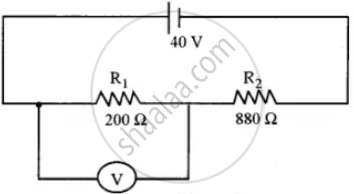
When the balance point is obtained in the potentiometer, a current is drawn from ______.
State the uses of a potentiometer.
What are the disadvantages of a potentiometer?
Describe with the help of a neat circuit diagram how you will determine the internal resistance of a cell by using a potentiometer. Derive the necessary formula.
A potentiometer wire has a length of 1.5 m and a resistance of 10 Ω. It is connected in series with the cell of emf 4 Volt and internal resistance 5 Ω. Calculate the potential drop per centimeter of the wire.
What will be the effect on the position of zero deflection if only the current flowing through the potentiometer wire is decreased?
Why is a potentiometer preferred over a voltmeter for measuring emf?
The emf of a cell is balanced by a length of 120 cm of a potentiometer wire. When the cell is shunted by a resistance of 10 Ω, the balancing length is reduced by 20 cm. Find the internal resistance of the cell.
When the null point is obtained in the potentiometer, the current is drawn from the ______
If the potential gradient of a wire decreases, then its length ______
The instrument which can measure terminal potential difference as well as electromotive force (emf) is ______
Two cells having unknown emfs E1 and E2 (E1 > E2) are connected in potentiometer circuit, so as to assist each other. The null point obtained is at 490 cm from the higher potential end. When cell E2 is connected, so as to oppose cell E1, the null point is obtained at 90 cm from the same end. The ratio of the emfs of two cells `("E"_1/"E"_2)` is ______.
The potentiometer is more sensitive, when ______.
The resistivity of potentiometer wire is 40 × 10-8 ohm - metre and its area of cross-section is 8 × 10-6 m2. If 0.2 ampere current is flowing through the wire, the potential gradient of the wire is ______.
Select the WRONG statement:
Which of the following is true for a potentiometer?
Sensitivity of a given potentiometer can be decreased by ______.
The length of a wire of a potentiometer is 100 cm, and the e.m.f of its standard cell is E volt. It is employed to measure the e.m.f of a battery whose internal resistance is 0.5 `Omega` If the balance point is obtained at `l`= 30 cm from the positive end, the e.m.f of the battery is ____________.
where 'i' is the current in the potentiometer
When two cells of e.m.f 1.5 V and 1.1 V connected in series are balanced on a potentiometer, the balancing length is 260 cm. The balancing length, when they are connected in opposition is (in cm) ____________.
In the given figure, battery E is balanced on 55 cm length of potentiometer wire but when a resistance of 10 `Omega` is connected in parallel with the battery, then it balances on 50 cm length of the potentiometer wire. The internal resistance r of the battery is ____________.
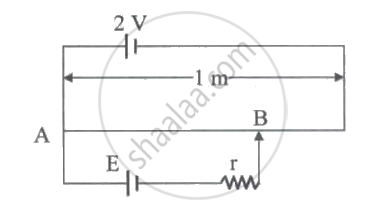
A potentiometer wire of length 100 cm and resistance 3 `Omega` is connected in series with resistance of 8 `Omega` and an accumulator of 4 volt whose internal resistance is 1 `Omega`.
A potentiometer wire has a length of 4m and resistance of 5Ω. It is connected in series with 495 Ω resistance and a cell of e.m.f. 4V. The potential gradient along the wire is ______
Two students X and Y perform potentiometer experiment separately and null point was obtained as shown in diagram. During the experiment, ______.
- X increases the value of R (resistance)
- Y decreases the value of S (resistance)
The position of null point obtained by students X and Y respectively.
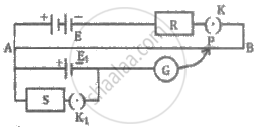
A battery is connected with a potentiometer wire. The internal resistance of the battery is negligible. If the length of the potentiometer wire of the same material and radius is doubled then ______.
In a potentiometer of 10 wires, the balance point is obtained on the 7th wire. To shift the balance point to 9th wire, we should ______.
AB is a wire of potentiometer with the increase in value of resistance R, the shift in the balance point J will be:

The conductivity of super - conductor is
What is the current I in the circuit as show in fig.
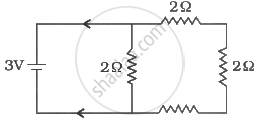
1°C rise in temperature is observed in a conductor by passing a certain current. If the current is double then the rise in temperature is approximately.
The instrument among the following which measures the e.m.f of a cell most accurately is ______
While doing an experiment with potentiometer (Figure) it was found that the deflection is one sided and (i) the deflection decreased while moving from one end A of the wire to the end B; (ii) the deflection increased. while the jockey was moved towards the end B.
- Which terminal + or – ve of the cell E1, is connected at X in case (i) and how is E1 related to E?
- Which terminal of the cell E1 is connected at X in case (ii)?
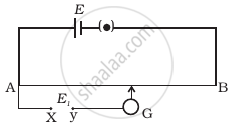
A Daniel cell is balanced on 125 cm lengths of a potentiometer wire. Now the cell is short circuited by a resistance 2 Ω and the balance is obtained at 100 cm. The internal resistance of the Daniel cell is ______.
In a potentiometer arrangement, a cell of emf 1.20 V gives a balance point at 36 cm length of wire. This cell is now replaced by another cell of emf 1.80 V. The difference in balancing length of potentiometer wire in above conditions will be ______ cm.
Two identical thin metal plates has charge q1 and q2 respectively such that q1 > q2. The plates were brought close to each other to form a parallel plate capacitor of capacitance C. The potential difference between them is ______.
Two cells of same emf but different internal resistances r1 and r2 are connected in series with a resistance R. The value of resistance R, for which the potential difference across second cell is zero, is ______.
In potentiometer experiment, null point is obtained at a particular point for a cell on potentiometer wire x cm long. If the length of the potentiometer wire is increased without changing the cell, the balancing length will ______. (Driving source is not changed)
A potentiometer wire AB having length L and resistance 12r is joined to a cell D of emf ε and internal resistance r. A cell C having emt `ε/2` and internal resistance 3r is connected. The length AJ at which the galvanometer as shown in the figure shows no deflection is ______.
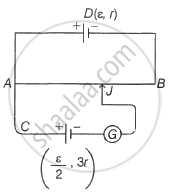
What is the effect of decreasing the current through the potentiometer on the null point?
State dimension of potential gradient.
Three identical cells each of emf 'e' are connected in parallel to form a battery. What is the emf of the battery?
